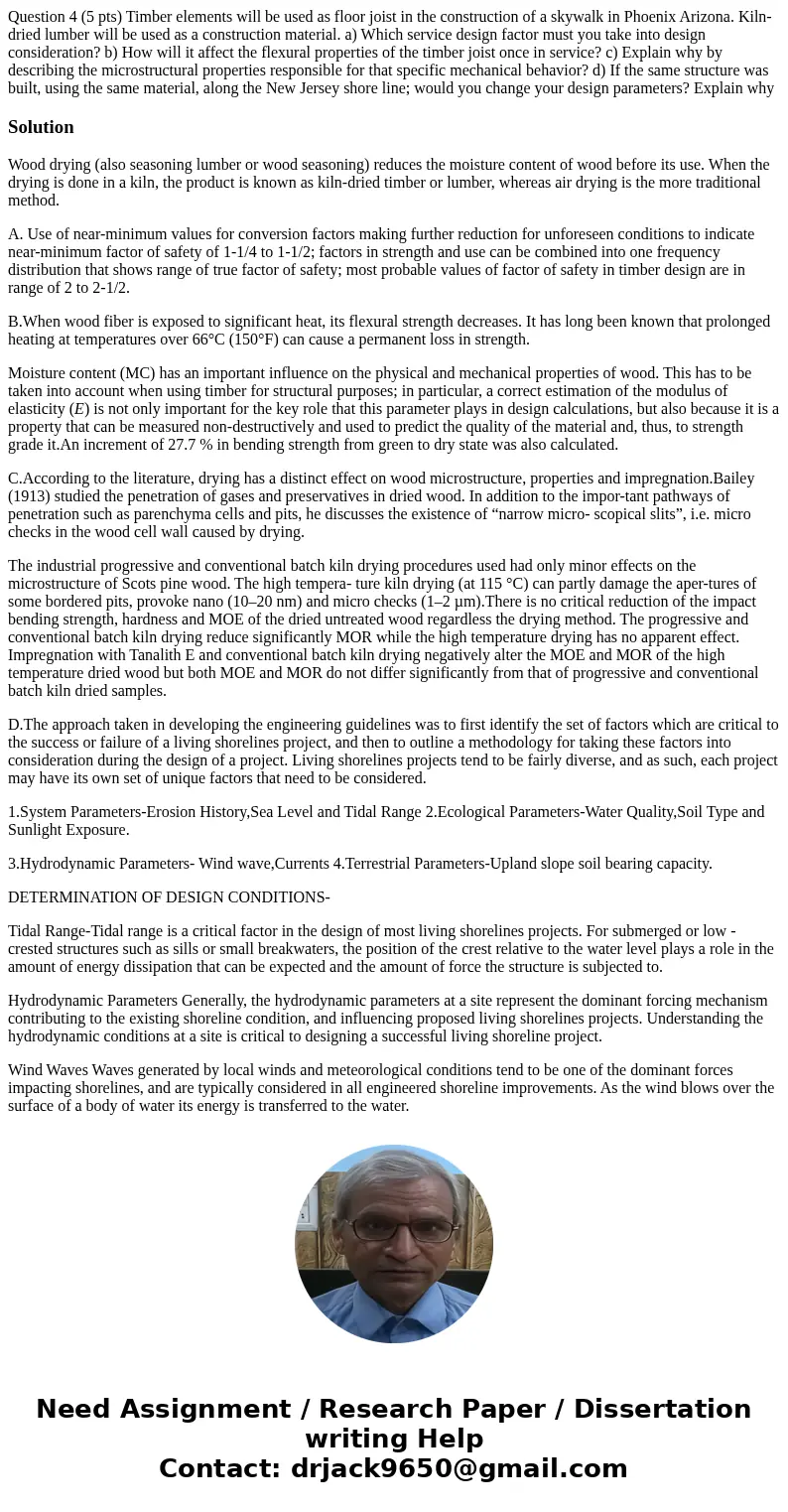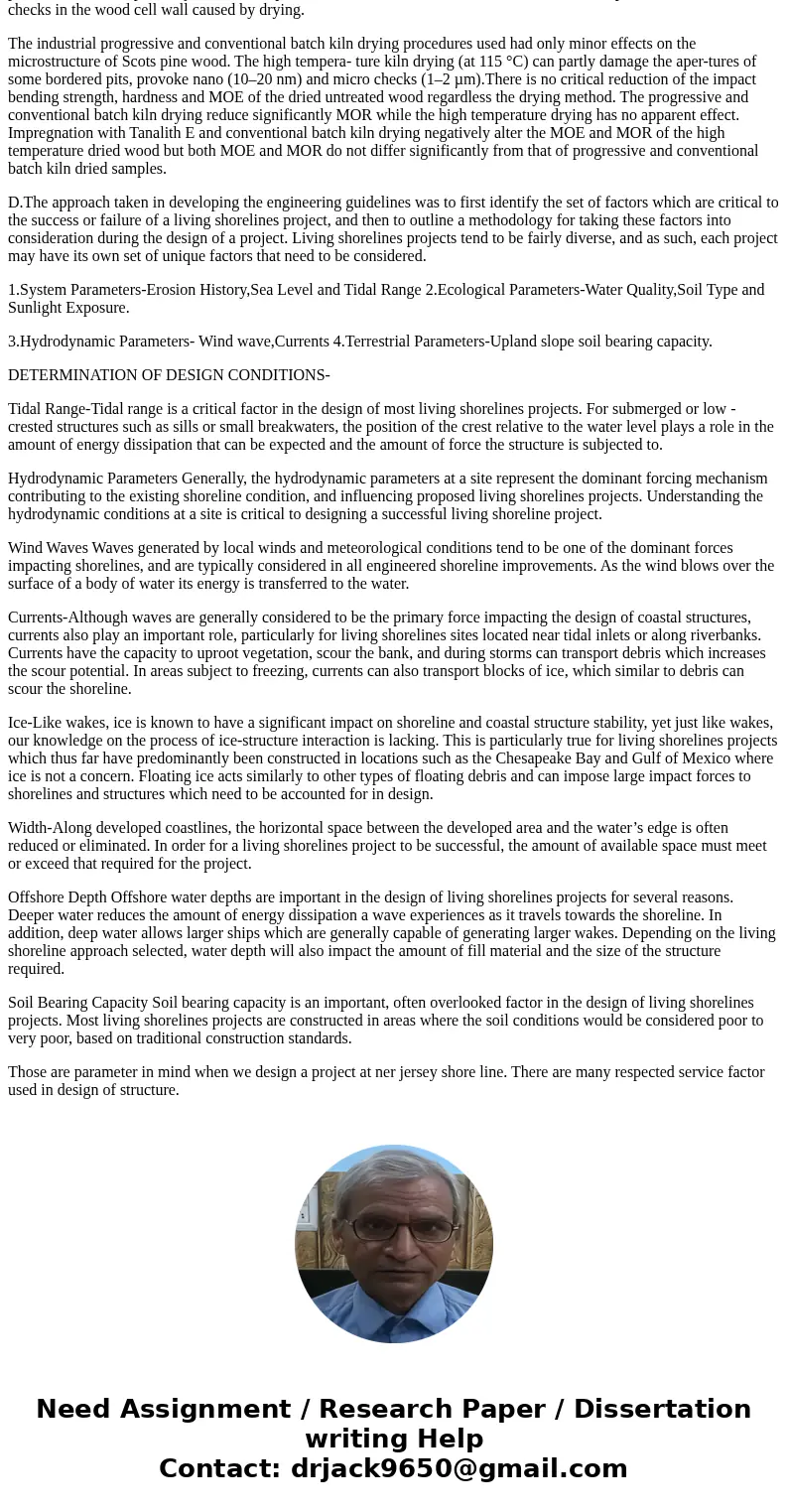Question 4 5 pts Timber elements will be used as floor joist
Solution
Wood drying (also seasoning lumber or wood seasoning) reduces the moisture content of wood before its use. When the drying is done in a kiln, the product is known as kiln-dried timber or lumber, whereas air drying is the more traditional method.
A. Use of near-minimum values for conversion factors making further reduction for unforeseen conditions to indicate near-minimum factor of safety of 1-1/4 to 1-1/2; factors in strength and use can be combined into one frequency distribution that shows range of true factor of safety; most probable values of factor of safety in timber design are in range of 2 to 2-1/2.
B.When wood fiber is exposed to significant heat, its flexural strength decreases. It has long been known that prolonged heating at temperatures over 66°C (150°F) can cause a permanent loss in strength.
Moisture content (MC) has an important influence on the physical and mechanical properties of wood. This has to be taken into account when using timber for structural purposes; in particular, a correct estimation of the modulus of elasticity (E) is not only important for the key role that this parameter plays in design calculations, but also because it is a property that can be measured non-destructively and used to predict the quality of the material and, thus, to strength grade it.An increment of 27.7 % in bending strength from green to dry state was also calculated.
C.According to the literature, drying has a distinct effect on wood microstructure, properties and impregnation.Bailey (1913) studied the penetration of gases and preservatives in dried wood. In addition to the impor-tant pathways of penetration such as parenchyma cells and pits, he discusses the existence of “narrow micro- scopical slits”, i.e. micro checks in the wood cell wall caused by drying.
The industrial progressive and conventional batch kiln drying procedures used had only minor effects on the microstructure of Scots pine wood. The high tempera- ture kiln drying (at 115 °C) can partly damage the aper-tures of some bordered pits, provoke nano (10–20 nm) and micro checks (1–2 µm).There is no critical reduction of the impact bending strength, hardness and MOE of the dried untreated wood regardless the drying method. The progressive and conventional batch kiln drying reduce significantly MOR while the high temperature drying has no apparent effect. Impregnation with Tanalith E and conventional batch kiln drying negatively alter the MOE and MOR of the high temperature dried wood but both MOE and MOR do not differ significantly from that of progressive and conventional batch kiln dried samples.
D.The approach taken in developing the engineering guidelines was to first identify the set of factors which are critical to the success or failure of a living shorelines project, and then to outline a methodology for taking these factors into consideration during the design of a project. Living shorelines projects tend to be fairly diverse, and as such, each project may have its own set of unique factors that need to be considered.
1.System Parameters-Erosion History,Sea Level and Tidal Range 2.Ecological Parameters-Water Quality,Soil Type and Sunlight Exposure.
3.Hydrodynamic Parameters- Wind wave,Currents 4.Terrestrial Parameters-Upland slope soil bearing capacity.
DETERMINATION OF DESIGN CONDITIONS-
Tidal Range-Tidal range is a critical factor in the design of most living shorelines projects. For submerged or low - crested structures such as sills or small breakwaters, the position of the crest relative to the water level plays a role in the amount of energy dissipation that can be expected and the amount of force the structure is subjected to.
Hydrodynamic Parameters Generally, the hydrodynamic parameters at a site represent the dominant forcing mechanism contributing to the existing shoreline condition, and influencing proposed living shorelines projects. Understanding the hydrodynamic conditions at a site is critical to designing a successful living shoreline project.
Wind Waves Waves generated by local winds and meteorological conditions tend to be one of the dominant forces impacting shorelines, and are typically considered in all engineered shoreline improvements. As the wind blows over the surface of a body of water its energy is transferred to the water.
Currents-Although waves are generally considered to be the primary force impacting the design of coastal structures, currents also play an important role, particularly for living shorelines sites located near tidal inlets or along riverbanks. Currents have the capacity to uproot vegetation, scour the bank, and during storms can transport debris which increases the scour potential. In areas subject to freezing, currents can also transport blocks of ice, which similar to debris can scour the shoreline.
Ice-Like wakes, ice is known to have a significant impact on shoreline and coastal structure stability, yet just like wakes, our knowledge on the process of ice-structure interaction is lacking. This is particularly true for living shorelines projects which thus far have predominantly been constructed in locations such as the Chesapeake Bay and Gulf of Mexico where ice is not a concern. Floating ice acts similarly to other types of floating debris and can impose large impact forces to shorelines and structures which need to be accounted for in design.
Width-Along developed coastlines, the horizontal space between the developed area and the water’s edge is often reduced or eliminated. In order for a living shorelines project to be successful, the amount of available space must meet or exceed that required for the project.
Offshore Depth Offshore water depths are important in the design of living shorelines projects for several reasons. Deeper water reduces the amount of energy dissipation a wave experiences as it travels towards the shoreline. In addition, deep water allows larger ships which are generally capable of generating larger wakes. Depending on the living shoreline approach selected, water depth will also impact the amount of fill material and the size of the structure required.
Soil Bearing Capacity Soil bearing capacity is an important, often overlooked factor in the design of living shorelines projects. Most living shorelines projects are constructed in areas where the soil conditions would be considered poor to very poor, based on traditional construction standards.
Those are parameter in mind when we design a project at ner jersey shore line. There are many respected service factor used in design of structure.


 Homework Sourse
Homework Sourse